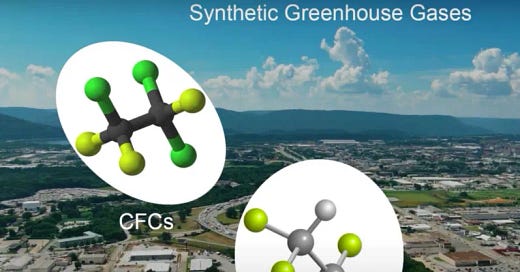What are HCFCs?
Hydrochlorofluorocarbons (HCFCs) are chemical compounds, essentially transitional gases consisting of hydrogen (H), chlorine (Cl), fluorine (F), and carbon (C). Their chemical structure includes carbon atoms bonded to hydrogen, chlorine, and fluorine atoms. Unlike CFCs (Chlorofluorocarbons), they also contain a hydrogen atom which lowers their stability and gives them a shorter lifespan in the atmosphere.
They mostly break down before they reach the ozone as they are being used to replace CFCs as part of the plan to reduce the emission of ozone-depleting gases. HCFCs are gases used in the manufacture of other chemicals.
What are the Applications of HCFCs around us?
HCFCs have been used in insulation materials and as cooling agents. They were used as substitutes for CFCs in insulation materials during the period 1991-1996 [1]
HCFCs are used as blowing agents in the production of foam insulation. They help create the cellular structure in foam products, which improves their insulating properties.
They are also used as solvents in precision cleaning applications, especially in the electronics and aerospace industries. Few examples are:
HCFC-22 (R-22): Used as a cooling agent in domestic, commercial and transport refrigerators
HCFC-123: Used in large commercial air conditioning systems, chillers, and cooling systems; used as fire extinguishing agent
HCFC-141b: Used in polyurethane and polyisocyanurate foam production as foam blowing agent; used as a cleaning solvent
HCFC-142b: Used in extruded polystyrene foam production.
HCFC-R22 (also known as Freon 22 and R22) has been the standard for use in residential air conditioners starting in the 1960s, when new houses often came with AC, through the mid 1990s with use decreasing through 2010. [2]
What is the environmental impact of HCFCs?
Despite not contributing to stratospheric ozone depletion to a great extent as of CFCs, they still contain chlorine and have the potential to destroy stratospheric ozone; they are viewed only as temporary replacements for the CFCs. [3]
HCFC refrigerants, CFC refrigerants, and HFC refrigerants all are harmful to environmental sustainability and are considered greenhouse gases. They all have high global warming potential (GWP) and are often found in air conditioning and other refrigerants, depleting ozone molecules.[4]
HCFCs play a major role in climate change and their adverse effects have impacted our environment negatively
HCFCs vs. CFCs
HCFCs are synthetic greenhouse gases that substitute CFCs (Chlorofluorocarbons)
The HCFCs have shorter atmospheric lifetimes than CFCs and deliver less reactive chlorine to the stratosphere where the "ozone layer" is found. Consequently, it is expected that these chemicals will contribute much less to stratospheric ozone depletion than CFCs
Ozone Depletion Potential (ODP): CFCs have a higher ODP compared to HCFCs.
Global Warming Potential (GWP): CFCs typically have a higher GWP than HCFCs.
Impact on Stratospheric Ozone: Both contribute to stratospheric ozone depletion, but CFCs have a more significant impact.
Breakdown Products: HCFCs break down more quickly in the lower atmosphere, resulting in fewer chlorine atoms reaching the stratosphere.
What Policies are implemented regarding HCFCs?
HCFCs are gases therefore that are to be gradually phased out. Their use is decreasing in developed countries, in particular, in line with the Montreal Protocol. This protocol aims to reduce the baseline to 90%. [5]
The Montreal Protocol,implemented in 1987, is a global agreement to protect the stratospheric ozone layer by considerably reducing the production and consumption of ozone-depleting substances (ODS). ODS are substances that are commonly used in products such as refrigerators, air conditioners, fire extinguishers, and aerosols. The Montreal Protocol has been approved by nearly all countries in the world.It aims to reduce the presence of ozone-depleting substances in our environment.
What are the present alternatives to HCFCs?
In spite of the adverse effects of HCFCs, there is a need to adapt to the Eco friendly alternatives of HCFCs. Natural refrigerants are substances that occur naturally in the environment. They have zero ODP and very low GWPs, making them highly sustainable options.
Project Drawdown’s Alternative Refrigerants solution consists of the gradual replacement of hydrofluorocarbons (HFCs), which are highly potent greenhouse gases, by alternative refrigerants, including ammonia, carbon dioxide, propane, and isobutane. [6]
Summary View
Hydrochlorofluorocarbons (HCFCs) have played a significant role in numerous household appliances and industries due to their effectiveness as refrigerants, solvents and fire extinguishing agents;replacing CFCs. However, their environmental impact cannot be overlooked. The global effort to phase out HCFCs, led by the Montreal Protocol is a crucial step towards a world where our environment is prioritised over other factors. It is also our responsibility to understand HCFCs and their effects to make more sustainable and healthier decisions for our planet and future generations, by transitioning to eco-friendly alternatives.
Works Cited
(Hydrochlorofluorocarbons(HCFCs) (https://utslappisiffror.naturvardsverket.se/en/Substances/Other-gases/Hydrochlorofluorocarbons/
CFC and HCFC Refrigerants and Climate Change https://www.kjtmechanical.com/webapp/p/592/cfc-and-hcfc-refrigerants-and-climate-change#:~:text=HCFCs%20contain%20chlorine%2C%20fluorine%2C%20and,before%20they%20reach%20the%20ozone
What are Hydrochlorofluorocarbons?https://gml.noaa.gov/hats/about/hcfc.html
The Environmental Impact of Refrigerants: CFC, HCFC, and HFC https://trakref.com/blog/environmental-impact-of-refrigerants/#:~:text=HCFC%20refrigerants%2C%20CFC%20refrigerants%2C%20and%20HFC%20refrigerants%20all%20are%20harmful,other%20refrigerants%2C%20depleting%20ozone%20molecules.
What is a HCFC and how does it work? - Area Cooling Solutionshttps://areacooling.com/hvac-glossary/hcfc/#:~:text=HCFC%20gases%20are%20used%20in,to%20the%20manufacture%20of%20foams.
Alternative Refrigerants | Project Drawdownhttps://drawdown.org/solutions/alternative-refrigerants




